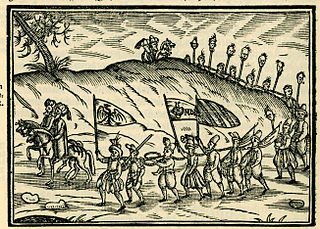Black people is a skin group-based classification used for specific people with a mid to dark brown complexion. Not all black people have dark skin; however, in certain countries, often in socially based systems of racial classification in the Western World, the term black is used to describe persons who are perceived as dark-skinned compared to other populations. It is mostly used for the people of Sub-Saharan African descent and the indigenous peoples of Oceania, Southeast Asia and the Indian subcontinent.

A slave rebellion is an armed uprising by slaves. Slave rebellions have occurred in nearly all societies that practice slavery or have practiced slavery in the past. A desire for freedom and the dream of successful rebellion are often the greatest objects of song, art, and culture amongst the enslaved population. Many of the events, however, are often violently opposed and suppressed by slaveholders.

Slavery in the colonial history of the United States, from 1600 to 1776, developed from complex factors, and researchers have proposed several theories to explain the development of the institution of slavery and of the slave trade. Slavery strongly correlated with Europe's American colonies' need for labor, especially for the labor-intensive plantation economies of the sugar colonies in the Caribbean, operated by Great Britain, France, Spain, and the Dutch Republic.

Abū ʿUthman ʿAmr ibn Baḥr al-Kinānī al-Baṣrī, commonly known as al-Jāḥiẓ was an Arab prose writer and author of works of literature, Mu'tazili theology, and politico-religious polemics.
Afro-Turks are people of Zanj (Bantu) descent in Turkey. Like the Afro-Abkhazians, they trace their origin to the Ottoman slave trade.
The Shirazis of the Comoros are one of the largest ethnic group inhabiting the archipelago nation of Comoros near the east African coast. Their origins are linked to Shiraz and the southwestern coastal region of Persia. The Shirazi people are notable for helping establish Sunni Islam in Comoros, and the wealth they accumulated from trading commodities and slaves.

The history of slavery spans many cultures, nationalities, and religions from ancient times to the present day. However the social, economic, and legal positions of slaves have differed vastly in different systems of slavery in different times and places.

Slavery in the Ottoman Empire was a legal and significant part of the Ottoman Empire's economy and traditional society. The main sources of slaves were wars and politically organized enslavement expeditions in North and East Africa, Eastern Europe, the Balkans, and the Caucasus. It has been reported that the selling price of slaves decreased after large military operations. In Constantinople, became the administrative and political center of the Ottoman Empire, about a fifth of the population consisted of slaves in 16th - 17th century. Sixteenth- and 17th-century customs statistics suggest that Istanbul's additional slave import from the Black Sea may have totaled around 2.5 million from 1453 to 1700.
The history of Afro-Brazilian people spans over five centuries of racial interaction between Africans imported, involved or descended from the effects of the Atlantic slave trade.
Afro-Iranians are people of Black African descent residing in Iran. Most Afro-Iranians are concentrated in the coastal provinces of Persian Gulf such as Hormozagan, Sistan and Baluchestan and Khuzestan.
The Shirazi people, also known as Mbwera, are an ethnic group inhabiting the Swahili coast and the nearby Indian ocean islands. They are particularly concentrated on the islands of Zanzibar, Pemba and Comoros. Their origins are linked to Shiraz and the southwestern coastal region of Persia. The Shirazi are notable for helping spread Islam on the Swahili Coast, their role in the establishment of the local Arab-Swahili sultanates, their influence in the development of the Swahili language, and the wealth they accumulated from trading commodities and slaves. The East African coastal area and the nearby islands served as their commercial base.

Afro-Asians are African communities that have been living in the Indian Subcontinent for hundreds of years and have settled in countries such as India, Pakistan and Sri Lanka.

The Battle of the Barges or Day of the Barges was fought on October 24, 869 near Basra. It was one of the first major engagements of the Zanj Rebellion, taking place less than two months after the outbreak of the revolt.

Slavery in the Muslim world first developed out of the slavery practices of pre-Islamic Arabia, and was at times radically different, depending on social-political factors such as the Arab slave trade. Throughout Islamic history, slaves served in various social and economic roles, from powerful emirs to harshly treated manual laborers. Early on in Muslim history they were used in plantation labor similar to that in the Americas, but this was abandoned after harsh treatment led to destructive slave revolts, the most notable being the Zanj Rebellion of 869–883. Slaves were widely employed in irrigation, mining, and animal husbandry, but the most common uses were as soldiers, guards, and domestic workers. Many rulers relied on military slaves, often in huge standing armies, and slaves in administration to such a degree that the slaves were sometimes in a position to seize power. Among black slaves, there were roughly two females to every one male. Two rough estimates by scholars of the number of slaves held over twelve centuries in the Muslim world are 11.5 million and 14 million, while other estimates indicate a number between 12 and 15 million slaves prior to the 20th century.















